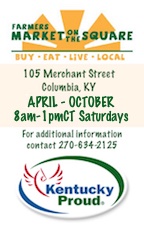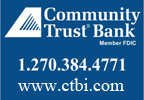| ||||||||||
Dr. Ronald P. Rogers CHIROPRACTOR Support for your body's natural healing capabilities 270-384-5554 Click here for details 


Columbia Gas Dept. GAS LEAK or GAS SMELL Contact Numbers 24 hrs/ 365 days 270-384-2006 or 9-1-1 Call before you dig Visit ColumbiaMagazine's Directory of Churches Addresses, times, phone numbers and more for churches in Adair County Find Great Stuff in ColumbiaMagazine's Classified Ads Antiques, Help Wanted, Autos, Real Estate, Legal Notices, More... 

|
Billy Joe Fudge: Jury still out on mass harvest of chestnuts Maybe not harvesting trees when chestnut blight hit our shores would not have saved his most magnificent tree. Today, a similar plight threatens Ash, as Emeald Ash Borer makes its way south from Michigan Comments re article 71512 Wonders how many Chestnuts might have survived if left alone from Brad Byington By Billy Joe Fudge Actually Brad, it went further than that in that the reality was that folks actually harvested healthy trees which were of large enough girth to be economically feasible for harvesting. Landowners were seeking to limit their losses when this devastating disease was brought to our shores around 1906. I understand your reasoning and that theory has been researched and explored for decades. The truth is, we will never know but since only the harvestable sized trees were cut, then there were multiple millions of healthy younger trees left across the Eastern Hardwood Forest in addition to millions of mature trees which could not be harvested before they actually died. We can, I think, safely surmise that not harvesting the trees would not have saved this most magnificent tree. Our Eastern Hardwood Forest is suffering through the loss of all species of Ash at present. The Emerald Ash Borer was brought into our country from the Orient some time around 2000 and was first discovered in Michigan. Since then it has been spreading south each year and is now killing Ash in the Lexington, Frankfort and Northern Kentucky area. This story was posted on 2014-11-27 08:49:55
Printable: this page is now automatically formatted for printing.
Have comments or corrections for this story? Use our contact form and let us know. More articles from topic Kentucky Color by Billy Joe Fudge:
Billy Joe Fudge: Root systems of 1,000s of chestnuts surviving Kentucky Color - Red Maple leaves upon the ground Kentucky Color: Springtime is sowing time Kentucky Color: Wild Black Cherry (Rum Cherry) Kentucky Color - More than an Old Fence Kentucky Color - Daddy Longlegs; or Harvestmen Kentucky Color - Crepe Myrtle, Shedding It's Skin Kentucky Color: Pesticide Free Thistle control Kentucky Color - They do not sow or reap Kentucky Color - Virginia Creeper View even more articles in topic Kentucky Color by Billy Joe Fudge |


|
||||||||
|
| ||||||||||
|
Quick Links to Popular Features
Looking for a story or picture? Try our Photo Archive or our Stories Archive for all the information that's appeared on ColumbiaMagazine.com. | ||||||||||
|
Contact us: Columbia Magazine and columbiamagazine.com are published by Linda Waggener and Pen Waggener, PO Box 906, Columbia, KY 42728. Please use our contact page, or send questions about technical issues with this site to webmaster@columbiamagazine.com. All logos and trademarks used on this site are property of their respective owners. All comments remain the property and responsibility of their posters, all articles and photos remain the property of their creators, and all the rest is copyright 1995-Present by Columbia Magazine. Privacy policy: use of this site requires no sharing of information. Voluntarily shared information may be published and made available to the public on this site and/or stored electronically. Anonymous submissions will be subject to additional verification. Cookies are not required to use our site. However, if you have cookies enabled in your web browser, some of our advertisers may use cookies for interest-based advertising across multiple domains. For more information about third-party advertising, visit the NAI web privacy site.
| ||||||||||




















































